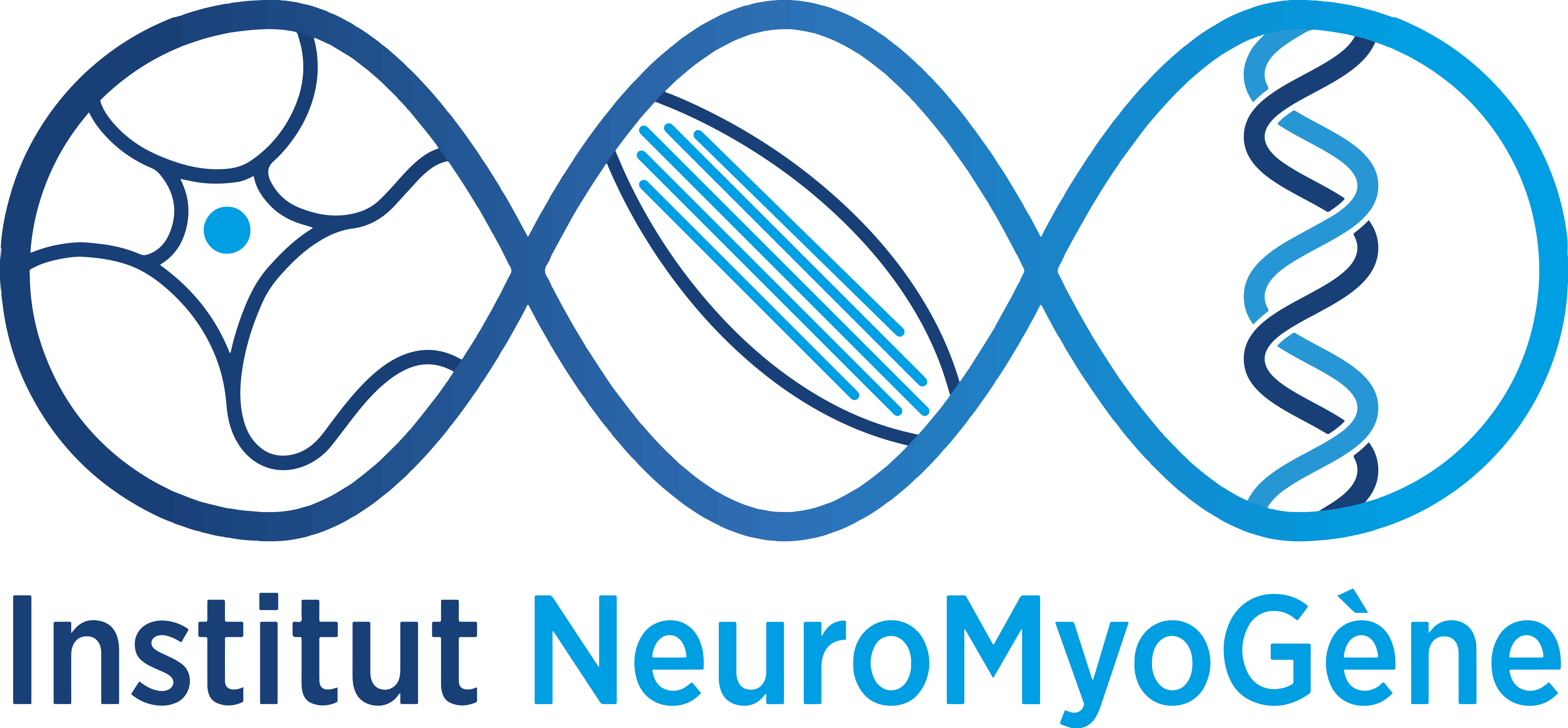L’équipe développe une série de thèmes de recherche dédiés au maintien de l’homéostasie du muscle squelettique. Certaines découvertes et techniques développées par l’équipe ont des implications directes pour le diagnostic ou le traitement des maladies neuromusculaires. L’équipe accueille des cliniciens impliqués dans des projets de recherche visant à développer des biomarqueurs innovants et à comprendre la physiopathologie des maladies neuromusculaires.

L’ÉQUIPE
- Laurent SCHAEFFER
PU-PH HCL UCBL1 - Liudmila AFANASEVA
DOCTORANTE - Edwige BELOTTI
POST-DOC UCBL1 - Julien CARRAS
EPHE - Zélia CHAUVAUD
Master 2 - Delia CICCIARELLO
Post-Doctorante - Agnes CONJARD-DUPLANY
CR INSERM - Laurent COUDERT
POST-DOC HCL - Yann-Gaël GANGLOFF
CR CNRS - Emmanuelle GIRARD
IR CNRS - Arnaud JACQUIER
AHU HCL UCBL1 - Nicolas LACOSTE
IR CNRS - Pascal LEBLANC
CR CNRS - Laetitia MAZELIN
CR INSERM - Sandrine MOURADIAN
IE CNRS - Peter MULLIGAN
CR INSERM - Alexis OSSENI
AHU HCL UCBL1 - Flavien PICARD
DOCTORANT - Alexandre PINTART
DOCTORANT - Mélodie PITCHECANIN
Master 2 - Shams RIBAULT
DOCTORANTE - Valérie RISSON
IR CNRS - Isabella SCIONTI
CR INSERM - Thomas SIMONET
MCU-PH HCL UCBL1
LES CLINICIENS
- Emilien BERNARD
PH HCL - Françoise BOUHOUR
PH HCL - Philippe LATOUR
PH HCL - Rita MENASSA
PH HCL - Laurence MICHEL
PH HCL - Antoine PEGAT
PH HCL - Nathalie STREICHENBERGER
MCU-PH HCL UCBL1 - Juliette SVAHN
PH HCL - Carole VUILLEROT
MCU-PH HCL

PROJETS
CELLULES SOUCHES MUSCULAIRES
Régulation épigénétique du devenir des cellules souches musculaires (Leader : Dr Isabella Scionti)
Le muscle squelettique a la capacité unique de se régénérer en cas de blessure. Cette capacité repose sur la présence de cellules souches musculaires (CSM), qui sont des cellules quiescentes. En réponse à une blessure, les CSM s’activent, prolifèrent et sont engagées dans un processus de différenciation ou d’auto-renouvellement afin de restaurer la réserve de CSM quiescentes. Notre projet vise à déchiffrer comment est régulée la transition du devenir des CSM, avec un accent particulier sur les lysines déméthylases (KDM). Outre les protéines histones, la méthylation de la lysine se produit également sur d’autres protéines, suggérant des rôles plus larges pour ces enzymes au-delà de la modification de la chromatine. Ainsi, nos objectifs sont de déterminer le rôle physiologique (au niveau transcriptionnel et post-transcriptionnel) de deux lysines déméthylases (LSD1 et PHF2) dans la régulation du choix du devenir des cellules souches musculaires, en utilisant des modèles de souris knock-out spécifiques aux cellules souches musculaires.
FIBRES MUSCULAIRES
Variants d’histone (Leader : Dr Edwige Belotti)
Les fibres musculaires sont des cellules multinucléées, post-mitotiques et à longue durée de vie, dont l’homéostasie est cruciale pour la fonction musculaire. Bien qu’il ait été démontré que les changements épigénétiques et la stabilité génomique sont cruciaux pour le maintien de l’homéostasie des fibres musculaires, la façon dont ces événements sont établis et coordonnés est mal étudiée. Plusieurs preuves indiquent que les variants d’histones, remplaçant les histones conventionnelles pendant la vie postnatale, jouent un rôle clé dans la plasticité musculaire. Ainsi, le projet vise à disséquer la fonction des variants histoniques dans les fibres musculaires post-mitotiques en utilisant des modèles knock-out spécifiques aux muscles.
Signalisation du TGF-β (Leader : Dr Laetitia Mazelin)
L’atrophie musculaire est un syndrome débilitant et potentiellement mortel associé à des maladies chroniques telles que le cancer, la myopathie, l’insuffisance pulmonaire et rénale obstructive chronique ainsi que la sarcopénie vieillissante. Les membres de la β famille des facteurs de croissance transformants, TGF-β, myostatine, activine, sont des régulateurs centraux de la masse musculaire. La diversité des ligands et des récepteurs empêche une description précise des conséquences de l’activation chronique du TGF-β par des approches classiques de gain et de perte de fonction. Nous avons développé un modèle génétique permettant l’activation inductible spécifique au muscle de la signalisation chronique du TGF-β. De nouvelles signatures moléculaires de l’atrophie musculaire émergeant de notre étude fourniront de futures perspectives thérapeutiques pour la prévention et le traitement de l’atrophie musculaire.
Signalisation mTOR (Leader : Dr Yann-Gaël Gangloff)
La dérégulation de la signalisation mTOR (mechanistic Target of Rapamycin) dans le muscle squelettique est une caractéristique commune à plusieurs myopathies, interventions thérapeutiques (par exemple, statines et glucocorticoïdes), et au vieillissement. Notre laboratoire a démontré un rôle critique de mTOR dans la régulation de l’intégrité musculaire et de l’homéostasie chez les souris. Nos projets de recherche visent à comprendre la contribution de la signalisation mTOR dans la physiopathologie des troubles neuromusculaires.
HDAC6 (Leader : Dr Alexis Osseni)
Nos travaux ont montré qu’en catalysant la désacétylation de la tubuline α et de Smad3, HDAC6 régule respectivement la distribution des récepteurs de l’acétylcholine et la signalisation du TGF-β dans les fibres musculaires, contrôlant ainsi l’organisation de la masse musculaire et de la jonction neuromusculaire. Une étude plus approfondie de l’HDAC6 dans la dystrophie musculaire de Duchenne et l’atrophie musculaire spinale a révélé de nouvelles stratégies potentielles de traitement pharmacologique à base d’inhibiteurs de l’HDAC6 pour les troubles neuromusculaires. Au total, notre objectif est de mieux comprendre le rôle de HDAC6 dans les cellules musculaires squelettiques et de développer l’utilisation des inhibiteurs de HDAC6 dans les troubles neuromusculaires.
NEURONE MOTEUR ET JONCTION NEURO-MUSCULAIRE
Troubles du repliement des protéines (Leader : Dr Pascal Leblanc)
Les pathologies impliquant des altérations du repliement des protéines (« protein misfolding disorders ») sont caractérisées par l’agrégation de protéines cellulaires présentant des propriétés rappelant celles des protéines prion normales et pathologiques (PrPC/PrPSc) impliquées dans les encéphalopathies subaiguës spongiformes transmissibles (ESST) comme la maladie de Creutzfeldt Jakob (MCJ). En effet, la protéine α-synucléine (dans les synucléopathies – maladie de Parkinson), Tau et le peptide amyloïde Aβ (dans la maladie d’Alzheimer et/ou les Tauopathies), la protéine Huntingtine (dans la maladie de Huntington) ou les protéines TDP-43, FUS et SOD1 (dans la sclérose latérale amyotrophique – SLA) sont retrouvées sous forme d’inclusions pathologiques dans le système nerveux central et/ou dans les tissus environnants comme les muscles squelettiques. En contexte pathologique, ces protéines induisent la co-agrégation et le changement de conformation des protéines normales respectives en protéines anormales ainsi que la propagation à plus ou moins longue distance des protéines mal conformées.
Deux maladies neuromusculaires sont étudiées au sein de notre laboratoire : la SLA ou maladie de Charcot et la myosite à corps d’inclusion (IBM pour « inclusion body myositis »). Dans ce contexte, notre premier objectif est d’étudier les mécanismes moléculaires et cellulaires par lesquels ces protéines pathologiques se retrouvent mal conformées et agrégées. Notre second objectif a pour but de caractériser les modes de sécrétion et de propagation des protéines mal conformées au cours du processus pathologique neurodégénératif.
En étroite collaboration avec les neurologues et les anatomopathologistes des Hospices Civils de Lyon (HCL), nous participons à l’identification de nouveaux gènes impliqués dans ces pathologies et dans la caractérisation de biomarqueurs candidats qui pourraient être utilisés pour le diagnostic et le suivi thérapeutique.
Deux maladies neuromusculaires sont étudiées au sein de notre laboratoire : la SLA ou maladie de Charcot et la myosite à corps d’inclusion (IBM pour « inclusion body myositis »). Dans ce contexte, notre premier objectif est d’étudier les mécanismes moléculaires et cellulaires par lesquels ces protéines pathologiques se retrouvent mal conformées et agrégées. Notre second objectif a pour but de caractériser les modes de sécrétion et de propagation des protéines mal conformées au cours du processus pathologique neurodégénératif.
En étroite collaboration avec les neurologues et les anatomopathologistes des Hospices Civils de Lyon (HCL), nous participons à l’identification de nouveaux gènes impliqués dans ces pathologies et dans la caractérisation de biomarqueurs candidats qui pourraient être utilisés pour le diagnostic et le suivi thérapeutique.
Maladies génétiques des motoneurones et de la Jonction Neuro-Musculaire (Leader : Dr Arnaud Jacquier)
Des gènes à la physiopathologie en passant par le traitement : les pathologies des motoneurones et de la Jonction Neuro-Musculaire impliquent plus de 100 gènes et beaucoup restent à identifier. L’objectif de cet axe est d’identifier et de caractériser de nouveaux gènes impliqués dans des pathologies telles que la maladie de Charcot-Marie-Tooth, l’atrophie musculaire spinale et les syndromes myasthéniques congénitaux. Les cellules souches pluripotentes induites par l’homme (hiPS) fournissent un moyen puissant pour modéliser les troubles génétiques des motoneurones et de la Jonction Neuro-Musculaire afin de comprendre la physiopathologie sous-jacente des gènes nouvellement identifiés et de proposer de nouveaux traitements.
SÉLECTION DE PUBLICATIONS
-
- LSD1 controls a nuclear checkpoint in Wnt/β-Catenin signaling to regulate muscle stem cell self-renewal.
Mouradian S.*, Cicciarello D.*, Lacoste N.*, Risson V., Berretta F., Le Grand F., Rose N., Simonet T., Schaeffer L.# and Scionti I.#.
Nucleic Acids Research (2024) doi.org/10.1093/nar/gkae060 - H2A.Z is involved in premature aging and DSB repair initiation in muscle fibers.
Belotti E.#, Lacoste N., Iftikhar A., Simonet T., Papin C., Osseni A., Streichenberger N., Mari P-O., Girard E., Graies M., Giglia-Mari G., Dimitrov S.#, Hamiche A.#, Schaeffer L.#.
Nucleic Acids Research (2024) doi.org/10.1093/nar/gkae020 - The new missense G376V-TDP-43 variant induces late-onset distal myopathy but not amyotrophic lateral sclerosis.
Zibold J., Lessard L., Picard F., Gruijs da Silva L., Zadorozhna Y., Streichenberger N., Belotti E., Osseni A., Emerit A., Errazuriz-Cerda E., Michel-Calemard L., Menassa R., Coudert L., Wiessner M., Stucka R., Klopstock T., Simonetti F., Hutten S., Nonaka T., Hasegawa M., Strom T., Bernard E., Ollagnon E., Urtizberea A., Dormann D., Petiot P., Schaeffer L., Senderek J. and Leblanc P.
Brain (2023) DOI: 10.1093/brain/awad410 - Spatial Transcriptomics Reveals Signatures of Histopathological Changes in Muscular Sarcoidosis.
Lequain H., Dégletagne C., Streichenberger N., Valantin J., Simonet T., Schaeffer L., Sève P., Leblanc P.
Cells (2023) DOI: 10.3390/cells12232747 - Novel Intronic Mutation in VMA21 Causing Severe Phenotype of X-Linked Myopathy with Excessive Autophagy-Case Report.
A. Pegat, N. Streichenberger, N. Lacoste, M. Hermier, R. Menassa, L. Coudert, J. Theuriet, R. Froissart, S. Terrone, F. Bouhour, L. Michel-Calemard, L. Schaeffer and A. Jacquier.
Genes (2022) DOI: 10.3390/genes13122245 - Immune-Mediated Rippling Muscle Disease Associated With Thymoma and Anti-MURC/Cavin-4 Autoantibodies.
J. Svahn , L. Coudert , N. Streichenberger, A. Kraut , A. Gravier-Dumonceau-Mazelier, L. Rotard , L. Calemard-Michel, R. Menassa, E. Errazuriz-Cerda, L. Chalabreysse, A. Osseni, C. Vial, L. Jomir, F. Tronc, D. Le Duy, E. Bernard, V. Gache, Y. Couté, V. Jacquemond, L. Schaeffer, P. Leblanc.
Neurology: Neuroimmunology & Neuroinflammation (2023) DOI: 10.1212/NXI.0000000000200068 - Pharmacological inhibition of HDAC6 improves muscle phenotypes in dystrophin-deficient mice by downregulating TGF-β via Smad3 acetylation.
A. Osseni, A. Ravel-Chapuis, E. Belotti, I. Scionti, Y-G. Gangloff, V. Moncollin, L. Mazelin, R. Mounier, P. Leblanc, B. J. Jasmin & L. Schaeffer.
Nature Communications (2022) DOI: 10.1038/s41467-022-34831-3 - Expanding the phenotypic variability of MORC2 gene mutations: From Charcot-Marie-Tooth disease to late-onset pure motor neuropathy.
A. Jacquier, S. Ribault, M. Mendes, N. Lacoste, V. Risson, J. Carras, P. Latour, A. Nadaj-Pakleza, T. Stojkovic, L. Schaeffer.
Human Mutation (2022) DOI: 10.1002/humu.24445 - Severe congenital myasthenic syndromes caused by agrin mutations affecting secretion by motoneurons.
A. Jacquier · V. Risson · T. Simonet · F. Roussange · N. Lacoste · S. Ribault · J. Carras · J. Theuriet · E. Girard · I. Grosjean · L. Le Goff · S. Kröger · J. Meltoranta · S. Bauché · D. Sternberg · E. Fournier· A. Kostera-Pruszczyk ·E. O’Connor · B. Eymard · H. Lochmüller · C. Martinat · L. Schaeffer.
Acta Neuropathologica (2022) doi: 0.1007/s00401-022-02475-8 - The ESCRT-0 subcomplex component Hrs/Hgs is a master regulator of myogenesis via modulation of signaling and degradation pathways.
L. Coudert, A. Osseni, Y. G. Gangloff, L. Schaeffer and P. Leblanc.
BMC Biology (2021) doi: 10.1186/s12915-021-01091. - HDAC6 regulates microtubule stability and clustering of AChRs at neuromuscular junctions.
Osseni A, Ravel-Chapuis A, Thomas JL, Gache V, Schaeffer L, Jasmin BJ.
J Cell Biol (2020) doi: 10.1083/jcb/201901099. - H2A.Z is dispensable for both basal and activated transcription in post-mitotic mouse muscles.
Belotti E, Lacoste N, Simonet T, Papin C, Padmanabhan K, Scionti I, Gangloff YG, Ramos L, Dalkara D, Hamiche A, Dimitrov S and Schaeffer L. Nucleic Acids Research (2020) doi: 10.1093/nar/gkaa157.
- LSD1 controls a nuclear checkpoint in Wnt/β-Catenin signaling to regulate muscle stem cell self-renewal.
FINANCEMENTS
![]()
![]()




![]()

Adresse
Faculté de Médecine
3ème étage, Aile B
8 Avenue Rockefeller
F-69008 Lyon

